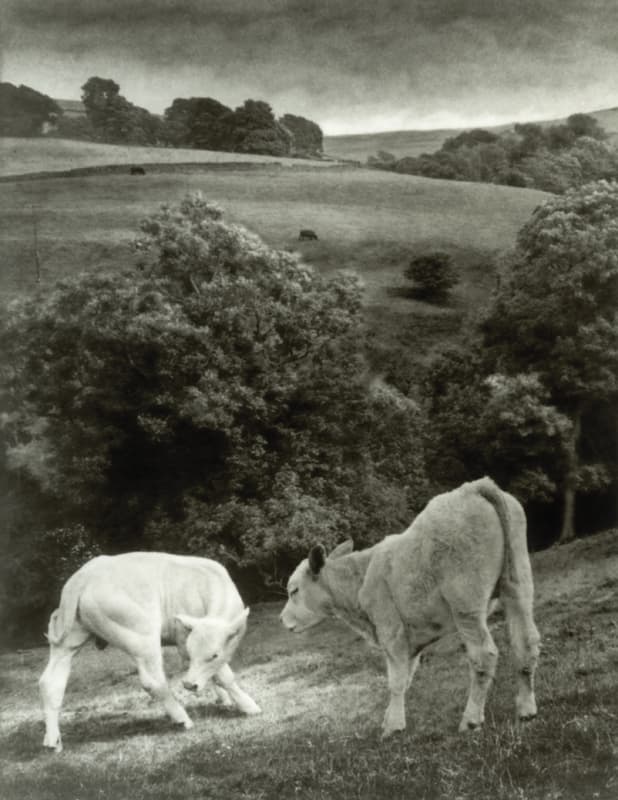Photo Insight with Andrew Sanderson
 A renowned photographer, tutor, author and Ilford Master Printer, Andrew Sanderson offers practical tips on working with film and traditional darkroom techniques
A renowned photographer, tutor, author and Ilford Master Printer, Andrew Sanderson offers practical tips on working with film and traditional darkroom techniques
There are times when I find it incredibly refreshing to take meandering drives around the countryside. It’s a great way to clear my head and to seek out inspiration for images. I’m not always alone and on the occasion that this image was shot a few friends accompanied me. After a few miles we decided to stop for a walk. After a while of wandering aimlessly, I looked over a wall and saw these two cows in a field – it was a scene that worked as a great foreground to the rolling hills in the background. As soon as I saw the cows, I whipped out my 35mm Contax 137 MD camera with 50mm lens and lined the frame up for a landscape shot. The two cows looked great through the viewfinder and gave the image a real sense of scale.
Just as I was about to take a picture, the white cow on the left lifted its back leg to scratch its head. As soon as I saw that happen, I knew I had a shot. I took one photograph and then the scene changed and the composition broke. I was pretty pleased and felt that I’d captured something quite strong, which was more than just an ordinary shot of two cows. But when I came to print the image the shot just didn’t have any life to it. I tried printing it various different ways, but I just couldn’t inject any drama. At that time I’d been doing a lot of paper negative work, but had been using paper within the camera. I’d become a little frustrated lugging heavy plate cameras around and coming back with paper negatives that were sometimes grossly over or underexposed. Paper negatives have a very fine latitude.
However, it occurred to me that I could take a film negative and then make a paper negative copy from that. This seemed like an ideal image from which to launch that idea. The cows in the image reminded me of the work by painter George Stubbs, who painted lots of pictures of horses and various other animals. The quality of light in those paintings was something that I was keen to try to recreate. You’ll notice the patch of white light surrounding the left-hand cow. That’s the kind of light you will only see in those old paintings – a detail picked out by a shaft of light. It’s not something you’ll see in real life, but it’s very dramatic and draws the viewer’s attention.
I produced my initial print from the negative (which of course gave me a positive image) and did all the necessary dodging and burning. Then I produced a paper negative. What I found was that I could add pencil to the first print to darken areas in the final image and then I could add pencil to the negative copy to lighten areas. It gave me much more control over the tonality of the final image.

It took me a couple of attempts to get it right, and it meant that by adding pencil I could add in highlights to the white cow to accentuate the muscles. I could also add light and slightly subdue the cow on the right, while adding in some sky and a subtle dark border around the edges of the frame. What this means is that when it comes to my final print I don’t have to do any burning or dodging – it is a straight print. This was my first attempt at pencil work and it spurred me on to keep going and develop my skills.
The shot was originally in 35mm landscape format, but once it came to printing I realised that it worked much better as a vertical composition so I cropped off the sides. With that in mind, the image you see is half of a 35mm frame.
I then realised that the image was losing sharpness as it went through the stages of film to paper to more paper. This means that the texture of the paper begins to come through as well as the pencil work, and the image ends up looking like a cross between a photograph and a drawing. People don’t quite know how to read these photographs. They’re photographs, but they’re partly illustrated. I enjoy the process because it’s hands-on and very rewarding, but more than that, it’s unique. Images like this are more about impressionism and mood than they are about sharpness. If I wanted an image to be sharp, I’d shoot on 10x8in, but then the sharpness becomes the point of the image. With methods such as paper negatives you’re not distracted by the sharpness as you’re far more concerned with composition and lighting. That’s what’s great about alternative processes and pinhole photography – you’re not distracted by detail. Detail is something to be left for the large-format photographers. With alternative processes a decrease in sharpness leads to an increase in aesthetic quality and interest.
It is funny how many people state that they are against manipulation in digital photography, because that is what photography is all about – manipulation. There is no such thing as a pure art form. It’s just what the artist perceives. My work is no different.

If you would like to read more about paper negatives, Andrew’s book Paper Negative Photography is available from www.blurb.com, price £15
Andrew Sanderson was talking to Oliver Atwell







